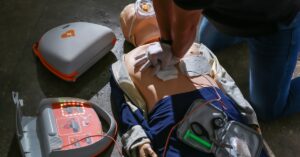As healthcare professionals, it is crucial to have a strong understanding of Pediatric Advanced Life Support (PALS) algorithms. Following the guidelines and using the correct approach helps you manage pediatric emergencies better and can help save a child’s life.
However, with a vast wealth of information, recalling all the necessary details during a high-stress situation is challenging. We’ve compiled some clever tips to help you remember PALS algorithms more effectively.
Use Acronyms
Think mnemonics when trying to retain complex information. One of the best ways to remember difficult concepts better is to use mnemonics and acronyms. For example, “ABCDE” can stand for Airway, Breathing, Circulation, Disability, and Exposure—the primary assessment for a pediatric emergency. Don’t stress about developing something immediately. Finding key, memorable letters to culminate the full process takes practice. Once you create acronyms using mnemonics, it becomes easier to remember and save valuable time during an emergency.
Practice Makes Perfect
While acronyms and mnemonic thinking help, repeated practice of each algorithm is just as essential, if not more. Attend PALS training sessions often and practice scenarios with your team. Also, consider using other study methods, such as flashcards or a simulator, to help you remember. The more you practice, the more confident and prepared you will be in a real emergency.
Use Online Resources
A wealth of online resources is available that can aid in your understanding of PALS algorithms. Interactive learning platforms, YouTube tutorials, and online flashcards are excellent tools for visual learners. Just make sure that the resources you use are credible and up-to-date.
Medical Social Media Groups
Platforms such as Facebook and LinkedIn host numerous groups where professionals in the healthcare field share helpful resources and experiences and host discussions of medical concepts. You can learn a lot about PALS algorithms and more by connecting to relevant social media groups.
Mobile Apps
Applications are always a popular method to study and reflect on old concepts. These products offer interactive quizzes, flashcards, and step-by-step guides that you can access right from your smartphone.
Webinars
Many reputable websites offer up-to-date information through webinars, and TedTalks can serve as lectures for healthcare professionals to return to later. These webinars can be valuable assets to help you stay updated on current trends and concepts, including PALS algorithms.
Podcasts
Even while you’re away from the textbooks, you can check in on relevant information in the medical field with podcasts. Podcasts have been a helpful way for professionals to learn and dive deeper into their understanding of tough concepts. Consider listening to a pediatric care podcast and learning something new while commuting, exercising, or during break times.
Adopt the Teach-Back Method
The “Teach-Back” method is a proven approach to reinforcing memory. After studying an algorithm, try to teach it to your peers or a non-medical person. Breaking down complex information into simpler terms helps solidify that information in your memory.
Remember, the ultimate goal of learning PALS algorithms is to provide the best possible care to our pediatric patients. Keep practicing, stay updated, and always be ready to apply your knowledge when it matters most.
Visual Aids
Visual aids can be incredibly helpful in memorizing information. Try creating diagrams, flowcharts, or posters that outline the steps of each algorithm. These visual cues can serve as quick reminders and help you recall the necessary actions during an emergency.
Categorize
Grouping similar information can make it easier to recall. You can categorize the PALS algorithms based on the type of emergency, such as cardiac arrest or respiratory distress. This way, you will have a mental map of where to find the necessary steps for each situation.
Dividing PALS algorithms into categories can streamline your thought process during a pediatric emergency.
Cardiac Emergencies
Use this category when learning about using PALS in cardiac emergencies. For example, Bradycardia and Tachycardia are two conditions to study. Focus on memorizing the different steps on reaction time, taking care of the patient, and administering medications such as Epinephrine and Atropine.
Respiratory Emergencies
Respiratory emergencies are a crucial part of PALS. Familiarize yourself with the algorithms that guide interventions such as oxygen administration, assisted ventilation, and potential intubation.
Shock
This category covers several types of shock, such as hypovolemic, distributive, and cardiogenic shock. Remember the specific interventions for each type, from fluid resuscitation to vasopressor administration.
Use Real-Life Examples
Sometimes, learning from real-life scenarios can be more effective than simply reading information from a textbook. Ask experienced colleagues to share their experiences and how they applied the PALS algorithms in different situations. This firsthand knowledge can help you understand and remember the steps better.
To illustrate the practical usage of PALS algorithms, let’s consider a couple of scenarios.
Example 1: Cardiac Arrest
Imagine you’re assisting a 4-year-old girl who suddenly collapses and is unresponsive. Your ABCDE acronym comes into play here. You check her airway and find it clear. She isn’t breathing, so you deliver two rescue breaths while another team member analyzes her circulation. After testing her circulation, a team member finds no pulse, indicating cardiac arrest. You immediately start chest compressions and call for the defibrillator, following the PALS cardiac arrest algorithm.
Example 2: Respiratory Distress
In another scenario, your new task is to assess a 2-year-old boy with severe asthma. He’s struggling to breathe and appears very distressed. In this scenario, you classify the emergency as respiratory distress. Following the PALS algorithm, you check the airway, provide supplemental oxygen (O2 therapy), and administer reliever medication under your “Respiratory Distress” category in your mental map of PALS algorithms.
Stay Calm
During an emergency, one thing to always remain is calm and not panic. Shaking, yelling, and aggressively reacting to an emergency will result in bad outcomes. Make sure that you stay relaxed because a clear mind helps you remember your training. Trust yourself and remember these steps to help remember the PALS algorithm while under stress.
Keeping your cool is essential for effective intervention. Use the following strategies to stay calm.
Deep Breathing
Deep, controlled breathing can help reduce panic and clear your mind, allowing you to remember your training more effectively.
Regular Practice
The more you practice the PALS algorithms, the more confidence you feel applying them during an emergency. Confidence can significantly reduce stress levels.
Teamwork
You’re not alone. Trust your team and rely on everyone’s knowledge and skills. Working together can make the situation less stressful.
Positive Visualization
Regularly visualize yourself successfully applying the PALS algorithms in an emergency, as it can help you stay calm and focused when the real situation arises.
The PALS algorithms offer a structured approach to handling pediatric emergencies, and with the use of strategies such as acronyms, repetition, and visual aids, you can enhance your memory retention. Regular practice and enrolling in an AHA PALS certification class can make a lifesaving difference in high-stress situations. At CPR123, we want to ensure you stay updated on PALS algorithms and more. Join us for a class or two to help you stay learning, practicing, and prepared to improve pediatric patient outcomes.








